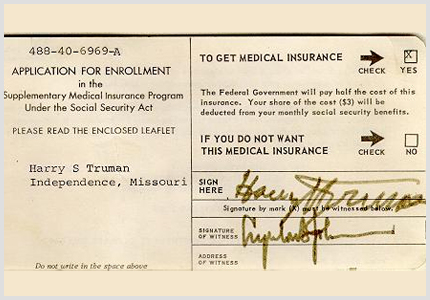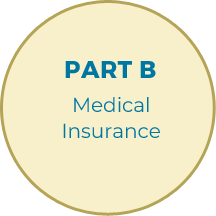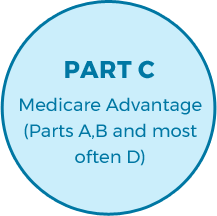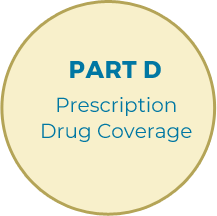One of the big questions we often get is:
What is the difference between a Medicare Advantage Plan and a Medicare Supplement Plan?
In this article, we will walk you through the differences between these two kinds of plans, how they fit into the Medicare program, what you can expect to pay for each of these plans, and how to get enrolled in them.

You will learn the advantages and disadvantages of each plan so that you can see which one fits your personal needs best.
As always, if you ever have any questions or concerns that we don’t cover in the article, we are happy to answer them and help you get all the information you need to make the best decision for you and your family.
Before we can start, we need to make sure you have a basic understanding of the Medicare program and what Original Medicare covers. Then our discussion about Medicare Advantage Plans and Medicare Supplement Plans will make more sense.
CONTENT
WHAT IS ORIGINAL MEDICARE?
Fundamentally, Medicare is a health insurance program that was created by the United States, established by the United States federal government in 1965. It was established to offer health care insurance to U.S. citizens who were aging. The program provides health care coverage (health insurance) for everyone over age 65, and also for some people who are under 65 who receive Social Security Disability Insurance (SSDI) or those that have end-stage renal disease (ERSD).

Medicare was established because the people in these groups—people over 65, and those with disabilities or kidney disease—had a hard time getting good health insurance from the private sector. Private insurance companies did not want to insure them and their premiums were too high to make it worth getting insurance.
For the insurance companies, it simply wasn’t a good return for them because these groups were high users of the healthcare system. But, this left many people without any kind of healthcare insurance at one of the most vulnerable times in their lives.
To solve this problem and make health insurance readily accessible to these hard-to-insure groups, the federal government created the Medicare program. In many ways, it acts as a social safety net.
The program is funded in part by the Social Security and Medicare taxes which are paid on income throughout your life, partially funded by the premiums paid by those using the Medicare program, and in part by funds from the federal budget.

WHAT IS MEDICARE?








Original Medicare is made up of two parts: Part A and Part B, which cover:
-
Part A (Inpatient/hospital coverage), with restrictions
-
Part B (Outpatient/medical coverage), with restrictions
1.Part A
 Part A is the portion of the Medicare program that covers all hospitalization and inpatient care.
Part A is the portion of the Medicare program that covers all hospitalization and inpatient care.
It is designed specifically to cover anything related to inpatient hospital costs.
Therefore, it pays for hospital bills and costs related to hospital care including medical care in a nursing home or skilled nursing facility. It will also cover hospice care and home health services when medically necessary.
Really any type of inpatient care falls under the coverage given by Part A, including prescription drugs received in a facility and inpatient medical supplies. If you are a homebound patient, this portion of Medicare will also cover physical or occupational therapy. For terminally ill patients, Part A also covers doctors, medication, and grief counseling.
Be aware that while Medicare Part A covers many hospital-related services, it doesn’t cover everything. If you need a service that is not covered, all providers are required to inform you before performing the treatment. The primary reason some inpatient medical expenses may not be covered is that they may not be categorized as “medically necessary.” For example, Medicare does not customarily cover custodial care in a skilled nursing facility, which is help with activities like bathing eating and getting dressed. These services are only be covered by Part A if you are in the nursing facility for medical treatment.
2.Part B
 The Part B portion of Medicare covers two things: Preventative services and medically necessary outpatient care.
The Part B portion of Medicare covers two things: Preventative services and medically necessary outpatient care.
Medically necessary services include all the medical care that is needed in order to diagnose and treat your medical conditions, including doctor visits, lab work, tests, and any necessary medical equipment or devices.
Preventive services refer to the medical care you get in order to prevent illness, like a flu shot or disease screenings and routine physicals.
Additionally, Part B also provides coverage for durable medical equipment (DME) outpatient mental health services, ambulance transportation, second opinions and a very limited supply of specific prescription drugs.
WHAT IS A MEDICARE ADVANTAGE PLAN?
When you enroll in Original Medicare you will pay a monthly premium for the plan as well as a yearly deductible for both Part A and Part B, as well as coinsurance which is 20% of any medical bills, inpatient or outpatient.
Also, Original Medicare does not provide a prescription drug benefit and if you want this you will need to pay an extra premium for a prescription drug plan. These plans are known as Part D.

For some people, these out-of-pocket costs for Original Medicare are still prohibitive and so an alternative plan with lower premiums was created. These plans have smaller or no deductible and no coinsurance costs. These plans are known as Medicare Advantage Plans or Medicare Part C.
Medicare Advantage plans have lower premiums because they work in particular service areas, meaning that you need to obtain your health care from specific providers and hospitals in specific areas where you live.
Additionally, Medicare Advantage Plans are administered by private insurance companies that contract with the federal government. Your monthly premiums are paid to the private insurance company. Additionally, most Medicare Advantage plans also contain a prescription drug benefit and so you do not need to purchase a separate Part D plan. Many Medicare Advantage plans also include dental and vision plans as well, and some even have additional services like memberships for gyms or stipends for healthy food delivery.
HOW A MEDICARE ADVANTAGE PLAN WORKS
A Medicare Advantage Plan works much like regular health insurance. You are still enrolled in the federal Medicare program, but the benefits are provided by a private insurance company and premiums are paid to them.
There are many different types of Medicare Advantage plans. We will describe the different kinds of plans you can choose below:

1.Health Maintenance Organizations (HMOs)
HMOs require you to use health-care providers in a designated plan network and may require referrals from a primary care physician in order to see a specialist.
2.Preferred Provider Organizations (PPOs)
PPOs have a list of recommended or “preferred” healthcare providers in a network and these plans will cover more of your medical costs when you stay in the network. Generally with PPOs you don’t have to get a referral to see a specialist.
3.Private Fee-for-Service (PFFS)
These plans determine how much the insurance company will pay your healthcare providers and how much you are responsible to cover.
4.Medical Savings Account (MSA)
PPOs have a list of recommended or “preferred” healthcare providers in a network and these plans will cover more of your medical costs when you stay in the network. Generally with PPOs you don’t have to get a referral to see a specialist.
5.Special Needs Plans (SNP)
These plans are created and tailored for are tailored for beneficiaries with certain health conditions.
As you can see, there is lots of flexibility available to you through a Medicare Advantage Plan. The costs and coverages of each one vary greatly from plan to plan and so if you decide that a Medicare Advantage plan is best for you, you will want to shop around and talk to an experienced Medicare insurance agent.
Some of the costs you will have with Medicare Advantage might include a monthly premium (not counting your Part B premium, which you must continue to pay as well), annual deductible, coinsurance, and copayments. However, for most people these are much lower than Original Medicare because of the restrictions in providers.
In order to enroll in a Medicare Advantage plan, you must be enrolled in Original Medicare which can happen when you are 65, you must reside in the plan’s service area, and (in most cases) not have end-stage renal disease (ESRD).
WHAT IS A MEDICARE SUPPLEMENT PLAN?
Because there are so many out-of-pocket costs associated with Original Medicare, many people were finding gaps in their coverage and unable to meet all these costs.
In order to cover the costs associated with Medicare Parts A and B, there is supplemental insurance offered by most states known as a Medicare Supplement Plan, or Medigap.

In exchange for an additional premium, a Medicare Supplement Plan can be obtained to help pay for medical costs not covered by Original Medicare.
Recognizing that Medicare doesn’t cover certain services, has deductibles, and also requires coinsurance of 20% of all medical bills, these plans are designed to help with these costs. These plans are provided by private insurance companies under the permission of the federal government. The government agreed to the establishment of these supplemental plans under the requirement that the insurance companies would provide ten different options that each had to meet specific governmental requirements.
The supplemental insurance plans vary in coverage options and costs, but depending on where you live, you have up to 10 different Medigap plans to choose from: A, B, C, D, F, G, K, L, M, and N. (Note that the plans in Wisconsin, Massachusetts, and Minnesota go by different names.)
Each type of Medigap policy, A-N, offers a different set of benefits and you can find one that best meets your needs. Keep in mind that premiums vary, depending on the plan you choose and the insurance company that provides the policy.
It’s also good to know that each individual insurance company decides which Medigap policies it wants to sell, although state laws might affect which ones they offer.
Insurance companies that sell Medigap policies do not have to offer every Medigap plan, must also offer a Medicare Advantage Plan, and must offer Medigap Plan A if they offer any Medigap policy.

The Medigap policy covers coinsurance only after you’ve paid the deductible, unless you have a Medigap policy that covers deductibles.
The chart below which was created by the federal government shows basic information about the different benefits Medigap policies cover.
| Medigap Benefits | Medigap Plans | |||||||||
|---|---|---|---|---|---|---|---|---|---|---|
| A | B | C | D | F* | G | K | L | M | N | |
| Part A coinsurance and hospital costs up to an additional 365 days after Medicare benefits are used up | Yes | Yes | Yes | Yes | Yes | Yes | Yes | Yes | Yes | Yes |
| Part B coinsurance or copayment | Yes | Yes | Yes | Yes | Yes | Yes | 50% | 75% | Yes | Yes*** |
| Blood (first 3 pints) | Yes | Yes | Yes | Yes | Yes | Yes | 50% | 75% | Yes | Yes |
| Part A hospice care coinsurance or copayment | Yes | Yes | Yes | Yes | Yes | Yes | 50% | 75% | Yes | Yes |
| Skilled nursing facility care coinsurance | No | No | Yes | Yes | Yes | Yes | 50% | 75% | Yes | Yes |
| Part A deductible | No | Yes | Yes | Yes | Yes | Yes | 50% | 75% | 50% | Yes |
| Part B deductible | No | No | Yes | No | Yes | No | No | No | No | No |
| Part Bexcess charge | No | No | No | No | Yes | Yes | No | No | No | No |
| Foreign travel exchange (up to plan limits) | No | No | 80% | 80% | 80% | 80% | No | No | 80% | 80% |
| Out-of-pocket limit** | N/A | N/A | N/A | N/A | N/A | N/A | $5,560 | $2,780 | N/A | N/A |
Yes = the plan covers 100% of this benefit
No = the policy doesn’t cover that benefit
% = the plan covers that percentage of this benefit
N/A = not applicable
HOW MEDIGAP WORKS
If you are enrolled in Original Medicare you will have Parts A, B, and you have the option to purchase part D to cover your prescriptions. This means you have coverage for hospital visits and stays, emergencies, doctor visits, lab work and preventive care, plus you have a list of drugs that are covered.
In order to receive these benefits, you will pay a monthly premium plus your deductibles and 20% of all your medical services, as well as any services that aren’t covered.

Now imagine that you need to have your hip replaced. One Washington Post article claims that this surgery can cost a patient anywhere between $10,000 and $125,000. If you have to pay 20% of those costs, you will need to pay $2,000-$25,000 out-of-pocket, just for the surgery. You will still have to also pay for the hospital stay, doctor fees, and possible rehabilitation and therapy.
Even with Medicare cover 80% of the cost, your medical bills are going to add up quickly. This is why many people choose to purchase an additional Medigap policy to help offset these medical costs. Depending on the type of plan you pick, A-N, determines how much of those costs will be covered.
Medigap policies, as we’ve already explained are provided by private insurance companies under the direction of the federal government and premiums are paid directly to them for your supplemental benefits. Just like with Medicare Advantage plans, the amount of coverage and the cost of the plans can vary greatly from plan to plan and from company to company.

MEDIGAP
ORIGINAL MEDICARE +
MEDIGAP SUPPLEMENT
Higher premiums but no co-pays
Freedom to choose doctors
No referrals necessary
Some routine services not covered (Vision, hearing)
Covered anywhere in US
MEDICARE ADVANTAGE
MEDICARE ADVANTAGE PLAN
Generally lower premiums but has co-pays
May be restricted to network
May need referrals for specialist
May include extra benefits (Vision, hearing, fitness)
Emergency service only outside service area
THE PROS AND CONS OF EACH TYPE OF COVERAGE
To ensure that you have full healthcare coverage with fewer out-of-pocket costs, it is very likely that will either need to choose a Medicare Advantage Plan or a Medicare Supplement Plan.
Each of these has advantages and disadvantages that you can weigh in order to decide which plan is right for you.

First, it’s important to note that you must already be enrolled in Original Medicare in order to enroll in either of these plans. And you have to stay in Original Medicare in order to use a Medicare Supplement Plan (Medigap).
1. Medicare Supplement Plans
 When choosing a Medigap plan, many people choose Plan F, which usually covers all deductibles and expenses, even those that occur when you are out of the country. Because this plan provides so much coverage, the premiums are high, but may be worthwhile for many people who don’t want to have their healthcare coverage restricted to certain coverage areas.
When choosing a Medigap plan, many people choose Plan F, which usually covers all deductibles and expenses, even those that occur when you are out of the country. Because this plan provides so much coverage, the premiums are high, but may be worthwhile for many people who don’t want to have their healthcare coverage restricted to certain coverage areas.
Another significant benefit of a Medigap plan is that it can give you flexibility and options so that you can shop around for the policy that best suits your healthcare needs and your lifestyle.
The disadvantage is that Medigap premiums are often higher than Medicare Advantage premiums. However, it may be worth it to you for the tradeoff—you get broader coverage and eliminate co-payments.
2. Medicare Advantage Plans
 The other alternative is to opt out of Original Medicare and any supplemental plans and instead choose a Medicare Advantage Plan. The reason for this is that most Medicare Advantage plans offer additional coverages, like prescription drug coverage and dental and vision plans.
The other alternative is to opt out of Original Medicare and any supplemental plans and instead choose a Medicare Advantage Plan. The reason for this is that most Medicare Advantage plans offer additional coverages, like prescription drug coverage and dental and vision plans.
These Part C insurance plans offer lots of variety and flexibility in coverage options and premiums and include extra services that would otherwise be unavailable. You can build a plan that is exactly right for your needs.
The biggest advantage of Medicare Advantage plans is that the premiums are generally less expensive than Original Medicare and a supplemental plan. They also provide more coverage as long as you stay within your service area and most plans include a limit to the amount of money you spend as a co-payment.
Perhaps the only downside to a Medicare Advantage plan is that you are required to stay in one network and you may incur healthcare expenses for any care that occurs outside of your services area.
INSURANCE PROFESSIONALS OF ARIZONA IS HERE TO HELP
Selecting between these two options Medicare is not easy and there are advantages and disadvantages to both. It can be helpful to talk with an independent Medicare insurance agent about your particular situation and needs.
Our agents, at Insurance Professionals of Arizona, can answer your questions, sort through the many options available—whether you want a Medicare Advantage Plan or a Medicare Supplement Plan—and help you figure out exactly which would be best for you.
We specialize in helping our clients navigate the Medicare program to get exactly what they need.

Admittedly, it is a confusing subject, with lots of exceptions and rules, but our agents are experts and are ready to help you understand it all.
Best of all, our agents always ensure that you get the right amount of coverage you need for the lowest premium. At IPA we have access to hundreds of plans provides by dozens of different carriers and can customize your healthcare policy so that it meets your needs and accommodates your personal budget.
You don’t have to figure out any of this alone. Let the independent agents at IPA use their knowledge and expertise to add value and insight as you make your healthcare decisions.
We’re here to help! Call us today.
NOW IT'S YOUR TURN
I hope this guide showed you the difference between IPA Medicare Advantage Plans vs Medicare Supplement Plans
And now I’d like to turn it over to you:
Did you learn something new from this guide?
Or maybe you have a question.
Either way, leave a comment below right now.

















Share your thoughts
Leave your comments